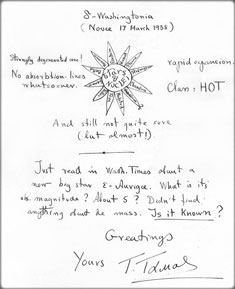Stellar- and nuclear energy
Bengt Strömgren contributed key new ideas about energy production in stellar interiors up until the start of the Second World War. He was called the ace of the conference at a special meeting in 1938 between the greatest theoretical physicists and astronomers - a meeting, which at the last moment gave life to the so-called CNO-process, which explains the production of nuclear energy in stars.

Strömgren's results of a high abundance of hydrogen in stars contributed to the understanding of stars' evolution as gigantic 'hydrogen burners', which convert enormous amounts of hydrogen to radiation. The question was simply how this happened and a dedicated group of astronomers did everything in their power to assert the importance of solving the energy problem.
A divide in Washington
In 1938 the Russian theoretical physicist Georgiy Gamov gathered a number of select physicists and astronomers, including Hans Bethe, Edward Teller, Nobel laureate Subrahmanyan Chandrasekhar and Bengt Strömgren, to a conference with the theme "stellar energy." Here, physicist Hans Bethe presented his important proposal for stellar energy production through the conversion of colliding hydrogen nuclei into helium nuclei, radiation and more hydrogen nuclei.

The CNO-process
The essence of Bethe´s theory was that four protons in one star fused into helium nuclei through a cyclical process in which carbon works as a catalyst (the CNO process). It later turned out that this process did not apply to the Sun, where the temperature is not high enough, but the process holds for stars that are heavier than the Sun.
In the Sun it is the so-called proton-proton-process at work which was also introduced by Hans Bethe. This contribution was later recognized as fundamental for all later work in the area of nuclear energy production - and Bethe received the Nobel Prize in Physics in 1967.
Bengt Strömgren had come a long way with his many colleagues around the world. They could in principal calculate the temperature of a star, its radius, luminosity, and the internal structure.
Now that the energy production as a result of the fusion of the light elements had fallen into place, Strömgren was closer to his goal, to increase man's knowledge of the Galaxy's (that is to say the Milky Way's) physical components and his theory about the predominance of the light elements in the stars and perhaps even the Universe was confirmed.
Letter from Gamov

Gamov was known his humoristic letters and in an invitation letter to the Washington conference in 1938, the Indian astronomer Chandrasekhar received this drawing. Gamov used the Greek symbol terminology in his promotion of the "new star delta-Washingtonia", which was "discovered" in March 1938. In the rays of the star, the names of the invited guests can be seen, including Albert Einstein, who did not take part in the meeting. Gamov wrote under this using Greek symbols. (source: Rebsdorf 2005, s. 287).
View letter enlarged >>
